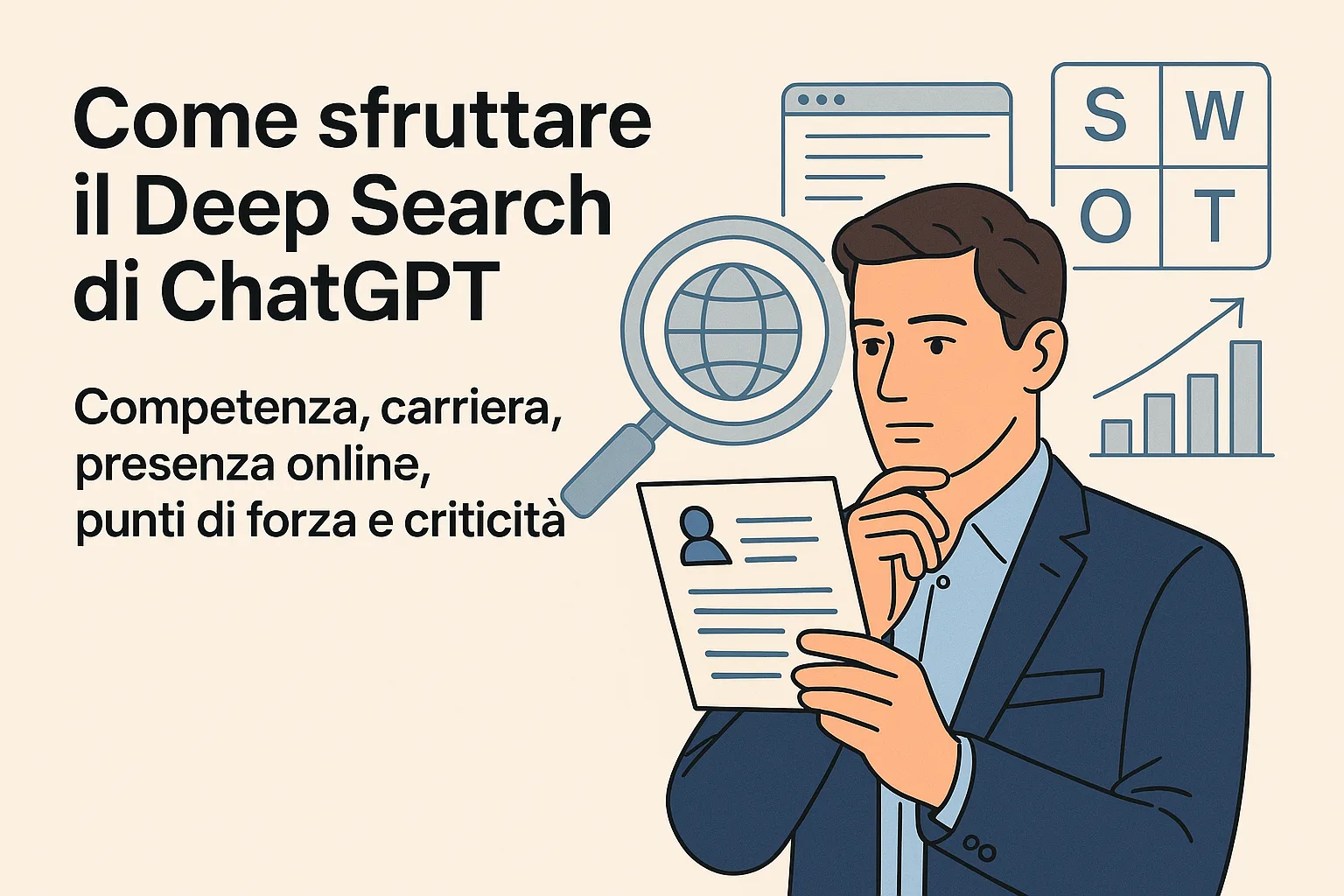
RENOR & Partners è una società di consulenza d'impresa con alti standard qualitativi e con i prezzi più bassi del mercato.
RENOR & Partners S.r.l.
Via Cicerone, 15 - Ariccia (RM)
info@renor.it
The AI that knows everything about you
The AI that knows everything about you

This post is also available in:
Italiano (Italian)
Today we discover how artificial intelligence can, through a “Deep Search”, return in just a few minutes a complete, structured, and professional overview of anyone — including skills, career, online presence, strengths, and weaknesses — in an automated way and without having to spend hours on manual research.
Introduction
Until recently, obtaining a detailed profile of a person — whether a potential partner, candidate, investor, or competitor — required hours of research across LinkedIn, Google, articles, résumés, social networks, corporate databases, and more. Today, thanks to Generative Artificial Intelligence and in particular the “Deep Search” feature available in ChatGPT and other platforms, this process can be automated in a surprisingly effective way.
This article explains step by step how this technology works, what advantages it offers compared to traditional research methods, which precautions to take to obtain useful results, and how to integrate it into your workflows that, as of now (May 2025), cannot yet be fully automated.
What is Deep Search
Deep Search is a set of prompt engineering and contextualization techniques that allows ChatGPT to generate a detailed and multidimensional analysis of a subject (person, company, or any other search entity), producing a structured response that includes, in the case of individuals for example, biographical, behavioral, psychological, professional, and communicative aspects.
For example, starting from a prompt like:
“Analyse Mario Rossi (mariorossi.com)”
It can return: a summary of the professional profile, strengths and weaknesses, the MBTI (Myers-Briggs Type Indicator), the psychological enneatype, decision-making style, a SWOT analysis, the predominant communication tone, a pitch to present to investors, and an estimate of perceived online reputation.
All of this is generated based on information available in the model’s training data, inferences drawn from common behavioral patterns, and internal coherence with the initial prompt.
It is evident that an analysis of this kind is only possible when there is online material available for the artificial intelligence to draw from. In any case, this activity does not constitute a violation of the individual’s privacy, precisely because it is based exclusively on publicly available data already accessible on the web.
Difference Between a Simple Prompt and Contextual Deep Search
In the world of generative artificial intelligence, not all prompts are created equal. A simple prompt is a direct request, often formulated in a single sentence, that produces an instant but generally superficial response. In contrast, contextual Deep Search represents a far more refined and powerful approach: it is based on a guided, layered conversation in which the user gradually builds context, steering the AI toward a deep and coherent analysis. It’s like the difference between asking, “Who is Mario Rossi?” and requesting, “Build a professional and psychological profile of Mario Rossi, CEO in the fintech sector, analyzing strengths, weaknesses, decision-making style, and communication impact.”
The latter approach, which can be activated by enabling the appropriate switch, is what we refer to as Deep Search. It doesn’t just list facts — it interprets, connects, and deduces, offering a complex synthesis that blends biography, personality traits, and developmental potential. It’s the closest thing to a well-conducted imaginary interview, performed with method and intelligence.
The Concept of Inference from Partial Data
One of the most fascinating aspects of next-generation artificial intelligence is its ability to infer complex information even from minimal or incomplete data. This process, known as inference from partial data, is based on the model’s capacity to recognize recurring patterns within vast sets of knowledge acquired during training. In other words, the AI doesn’t need to “know everything” to reconstruct a plausible picture: a few clues — a name, a role, a company — are enough to trigger a deductive mechanism capable of generating a coherent and structured representation of the person or context being examined. This is not imagination, but plausibility built upon statistical logic and probabilistic relationships between pieces of information.
This makes artificial intelligence not just a consultative tool, but a cognitive synthesizer capable of simulating deep knowledge even when the starting point is highly fragmented.
How ChatGPT Combines Known Sources, Patterns, and Deductive Logic
Let’s begin by noting that, unlike traditional prompts which rely solely on information stored within the model, ChatGPT’s Deep Search function leverages an incredibly powerful additional component: real-time web browsing. When Deep Search is activated, the AI accesses the internet directly through Bing, searching for up-to-date and relevant sources in order to build a response based not only on statistical inference, but also on current data, official statements, social media profiles, news articles, and authoritative sources. This allows it to constantly update and refine the profile being analyzed, by combining known sources, recurring patterns, and deductive logic. The result is a deeply contextualized representation, merging the immediacy of generative intelligence with the accuracy of real-time web-based documentation, maintaining a balance between deduction and verification. It is this synergy between AI and intelligent web crawling that makes Deep Search an unprecedented tool for gathering strategic insights about people, companies, or phenomena in real time.
In What Contexts Can an AI-Generated Profile Be Useful?
Artificial Intelligence has no emotions and simply provides objective analyses based on the information it finds online. Among the contexts in which it can prove useful are:
When we use it on a personal level
Deep Search analysis can prove extremely valuable on a personal level. Asking artificial intelligence for a neutral and contextualized evaluation of your own profile allows you to observe yourself from an external, objective perspective, free from emotional bias. This form of assisted self-reflection can help bring to light strengths that are often underestimated, but more importantly, it can clearly identify areas for improvement, dysfunctional behaviors, or limiting patterns that may hinder personal or professional growth. It’s like holding up a mirror to yourself — but with the analytical objectivity of a tool that doesn’t judge: it observes, processes, and offers constructive insights.
Of course, one must be prepared to receive criticism as well — feedback that may highlight underappreciated aspects or even vulnerabilities we tend to overlook. Ultimately, it’s important to understand that an analysis conducted by a system unaffected by emotional ties does not deliver a judgment, but rather offers something that can be useful for our personal growth. It requires clarity of mind, openness, and a healthy sense of self-criticism.
When Used in the Intermediate Phase of Job Interviews
In the selection process for engineering roles, where recruiting is structured into multiple phases, the introduction of Deep Search can serve as a valuable tool during the intermediate stage. After the résumé screening and the initial interview, and before the technical assessment, it is possible to insert a phase of in-depth analysis powered by artificial intelligence. At this point, the recruiter can provide ChatGPT with the information gathered during the previous interview (such as responses given, observed behaviors, or preliminary impressions), enriching it with real-time web research. The model is then able to deliver a neutral, contextual, and well-reasoned evaluation of the candidate, highlighting the consistency between their online presence and personal communication, potential soft skills not explicitly stated, relational style, and cultural compatibility with the company. This approach does not replace human judgment, but rather complements it with an objective analytical lens, supporting more informed and well-rounded decision-making.
When We Want to Use It in Investigative, Legal, or Academic Applications
In addition to its use in personal, HR, and commercial contexts, the Deep Search function also finds valuable applications in investigative, legal, and academic settings. In the investigative field, it can be employed to build preliminary profiles of subjects of interest, reconstructing connections, past activities, digital traces, and publicly documented behaviors — all without accessing confidential archives or infringing on privacy. In the legal domain, it can assist lawyers or technical consultants in the contextual gathering of public information on opposing parties, witnesses, experts, or companies involved in proceedings, providing a concise yet structured overview that helps shape defense or negotiation strategies. On the academic side, Deep Search proves useful for quickly analyzing the profiles of authors, scholars, or researchers, generating basic bibliographic overviews or comparing theoretical approaches across different schools of thought. Naturally, in all these cases, it is essential to remember that the AI merely reprocesses publicly accessible information, delivering plausible and structured interpretations — but not certified or legally admissible evidence. It is a tool for support and orientation, not a substitute for official sources.
Can I ask for more?
Absolutely yes — once the search has been carried out, it is possible to request any other type of information that can be inferred from the completed deep search.
For example: “Provide me with a SWOT analysis of Mario Rossi.”.
The model will then elaborate strengths, weaknesses, opportunities, and threats in relation to the professional context, current position, and declared or inferred skills. But it doesn’t stop there: you can go further by requesting a leadership style assessment, a behavioral interview simulation, a pitch to present to potential investors, or even a cultural compatibility analysis with a specific company.
This makes Deep Search not just an informational tool, but a strategic dialogue environment, where each piece of information becomes the starting point for a new inference, a new perspective, a new use case — fully customizable according to the objectives of the user.
Conclusions
The introduction of Deep Search in AI interactions represents a significant leap forward in the everyday use of generative models. It is no longer about receiving simple answers to isolated questions, but rather about obtaining truly structured analyses, based on a combination of real-time web research, deductive inference, and cognitive modeling. Whether it’s for personnel selection, business scouting, investigative insights, self-analysis, or academic support, Deep Search allows us to save time, increase depth, and broaden the perspective through which we understand individuals and contexts. Like any powerful tool, it requires conscious and responsible use, fully aligned with current ethical and legal frameworks. But for those who know how to ask the right questions — and have the courage to hear even the most uncomfortable answers — AI can become an extraordinary ally in understanding both the world and oneself.
- Want to save the planet? Make them work from home, you moron! - June 22, 2025
- Will AI make people lose jobs? - June 17, 2025
- Evaluation of the level of Blur by Laplacian Variance - June 15, 2025

